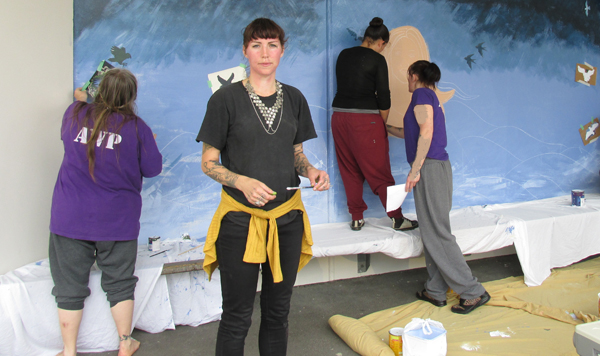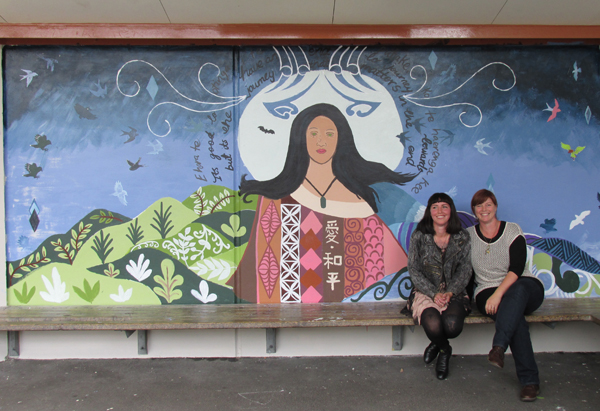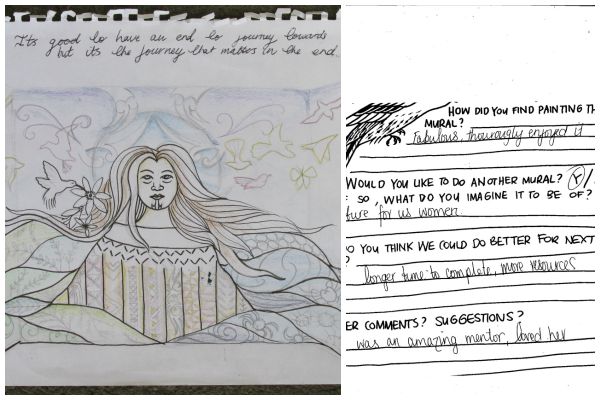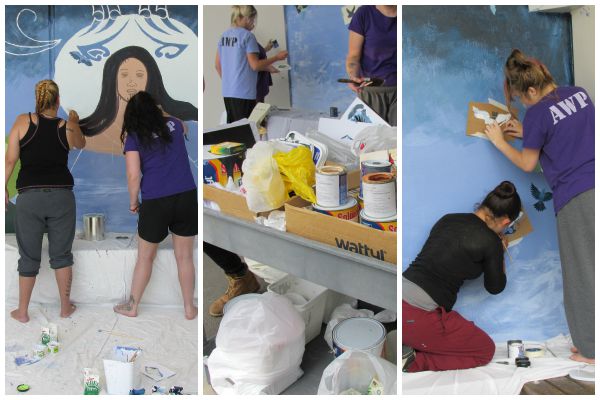Collaborative mural project at Arohata Prison
28 September 2015
More than 30 women prisoners in the Tizard Unit at Arohata Prison worked together to plan, create and paint a large mural which was completed earlier this year. Artist Sarah Hocquard volunteered to facilitate the mural project, supported by Porirua based art teacher Kiri Hiha.
The first introductory visit at Arohata Prison took place in early November 2013 and the project was completed with a blessing in February 2015.
Sarah’s background
Sarah participated in her first collaborative arts project in Melbourne after studying Visual Arts at RMIT University and immersed herself in the street art community.
“We did a lot of collaborative murals, group shows and I co-organised an art market at our Warehouse 'Antiverse' in Brunswick. It was a very exciting time,” Sarah says.
One of the last projects Sarah worked on in Melbourne was The Interlocation Project, which involved fundraising to fly three Indonesian artists from Jojakarta to collaborate with other artist living in the city.
“I learnt so much from this experience and wanted to share that with others,” Sarah says. “These experiences made me value the immense potential, art has to empower and strengthen communities, and also its ability to completely transform spaces.”
Arriving back in New Zealand in 2013 Sarah saw the relevance of transformed spaces through collaborative art in prison and she approached Jacqui Moyes, Arts in Corrections Advisor, to help her with the mural project.
“Jacqui agreed to meet with me and straight away was very excited and helpful. I don’t think I would have managed the initial stages without her.”
The Process
After Sarah approached Jacqui to talk about volunteering her time to manage a mural project, she introduced Sarah to the Prison Manager.
“Sarah is a very skilled professional artist who shares her enthusiasm for the creative process easily,” Jacqui says.  “She demonstrated the importance of engaging with the process of making art, and succeeded in producing a collaborative artwork that reflects the community she was working with.”
“She demonstrated the importance of engaging with the process of making art, and succeeded in producing a collaborative artwork that reflects the community she was working with.”
Sarah met with then Prison Manager, Ann Abraham, she completed a site visit, submitted a proposal, and completed her Volunteer Application Form.
Sarah was looking for someone to work with her on the project, and Porirua based art teacher Kiri Hiha joined the project.
After Sarah and Kiri completed a few planning workshops with the group of women in the unit, and had discussions about what they would like to paint, they drew up a dozen different mural plans.
They presented the options to the women, and Sarah explains “it was our angle all the time, to facilitate (rather than design) the painting of the mural.”
Once the chosen design and necessary equipment was approved by the Prison Manager, the group started painting.
The final mural design was a central female figure wearing a cloak inspired by the Korowai. The women painted a different pattern from the various cultures they identified with, within the vertical strips included in the design.
Stylized hills depicting various nature elements, represents the flora and fauna the women have a connection to, but are currently separated from.
“We had a lot of great input and discussions about what should be in the mural, one woman requested a bat be included in the mural design. For her a bat is a symbol of rebirth as it emerges from its cave and that was really special to her.”
She remembers a woman’s suggestion to include a quote by American author Ernest Hemingway:
‘It is good to have an end to journey towards; but it is the journey that matters, in the end’
“That really resonated with all the women so the quote became a central part of the mural” Sarah says.
“Witnessing the strength and vitality these women still have in spite of their current environment was phenomenal. It was a real privilege to work with them to create something like this together.”

Evaluation and documentation
Sarah designed a brief evaluation form to gather feedback from the women about their experience of the project.
When asked about their experience working on the mural project many of the woman found it a positive experience, one woman said it was “therapeutic and fun” and another commented ”Amazing, was a great experience.”
Sarah also requested that photographs were taken by a staff member at the beginning, middle and end of the project to record the development of the mural.
Challenges and successes
Sarah says she found the more involved in the process the women became, and the more they took pride in the mural, they truly committed to finishing it in the short time they had to complete it.
Working in a remand unit can be challenging.
“You’d form connections with people, but then they won’t be there the next week,” Sarah says. “It was important to get the woman who came into the project at a later stage on the same page and make them feel like they were a part of the project.”
“There were a lot of women coming and going, but it also worked really well because of that reason. The women were eager to help the newcomers and explain the project to them.”
Sarah’s advice to anyone wanting to complete a mural project in a prison
Something I found really helpful was making sure after every session I set aside time to write down everything that happened.
A lot happens in the few hours you are in the prison and it’s really helpful to have something to refer back to later to see what you can improve on next time and reflect on how your sessions went.
Another thing that is very important is patience. Expect the project to take longer than anticipated. Expect delays and only commit to doing the project if you can envision still being interested in it even if it does take longer than originally estimated.



